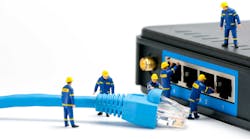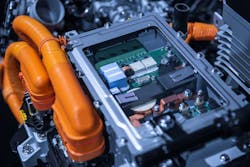System Connectivity is Crucial to Functionality, Reliability, and Safety
Members can download this article in PDF format.
What you’ll learn:
- The importance of connectivity.
- How connectivity issues can impact performance, reliability, and safety.
- Things to look for in a connectivity solution.
In our advanced, connected, electronically oriented society, device-based solutions are penetrating more application spaces than ever. This expansion places hardware systems into extreme situations that they must be prepared to handle.
Most think that exposing hardware to wet and dirty situations is all they have to worry about when it comes to harsh environments. While that assumption is mostly correct, it’s incomplete. In addition to moisture and dirt, electronic systems intended for use in challenging environments must be able to handle vibration, shock, and thermal situations as well (Fig. 1).
This is especially important in government- and municipality-oriented application spaces such as military/aerospace and civil engineering, where failure may not only result in loss of human life, but may contribute to a significant civil, political, or strategic impact. Mission failure in these situations is unacceptable, and demand not only the best-performing solution available, but also one that’s safe and reliable in the field.
Even though a complex electronic system may be highly sophisticated, unless the interconnections between the subsystems involved are robust and rugged, the overall design is at risk of failure. Like any chain, a system is only as good as the performance of its least-capable link.
Addressing Survivability
Connector safety and reliability is an aspect that cannot be overstated. A poorly designed plug polarity and fit may not only present risk in operation—if the connector interface is poor to lock in place or difficult to implement, it could cause user workarounds that can result in even greater risk situations to operators and equipment.
The performance of the cabling and interconnects are directly related to the safety of the facility and its operators (Fig. 2). For example, on January 26, 2013, on a Spartan Offshore Drilling rig operating for Bois d’Arc Exploration offshore in the Gulf of Mexico, a worker for Baker Hughes, a cementing contractor, was troubleshooting an electronic failure. Evidence suggests that he suspected a discharged battery in a box that supplied dc power as the problem.
Unfortunately, when he attempted to fix the problem by plugging in a 115-V three-wire extension cord, he was subsequently killed by electrocution. A Bureau of Safety and Environmental Enforcement (BSEE) panel investigated the incident, determining that at some point prior to the fatal incident, moisture entered the electrical connection of the battery box and extension cord. This was caused by a short-circuit in the female plug end of the extension cord, which had a burned-out ground wire inside.1
This human loss could have been prevented if the cable and connection systems involved were rugged and reliable enough to ensure proper operation under any foreseeable environmental condition. Heat, humidity, dust, and vibration are safety and reliability challenges, and both the operator and the equipment are key implications when addressing systems deployed in harsh environments.
The quest for optimum performance, safety, and reliability begins at the board level. If the subsystem can’t handle high temperatures, shock, and vibrations, good cables can’t fix package-level issues. There are many ways to address these issues, including recently introduced materials that can handle high temperature, radiation, shock, and even chemically corrosive environments for extended periods.
In addition to wide-bandgap (WBG) semiconductor materials such as silicon carbide (SiC) and gallium nitride (GaN) on the chip side, other solutions like aluminum nitride (AlN) can replace beryllium oxide (BeO) in the semiconductor industry. Not only does AlN address BeO’s toxicity, its thermal expansion coefficient is lower than BeO or alumina, closely matching that of silicon wafers.
This enclose-and-protect approach extends to the packaging, which must be made of materials appropriate to the application as well as be resistant to environmental extremes. Beyond encompassing the system, the enclosure presents the user interface and I/O capabilities to the world. Any packaging must not only address form and function, but also harsh-environment resistance. Even the most basic electronic products can leverage legacy solutions like board cladding, potting for thermal transfer and shock absorption, and ruggedized packaging.
Only by providing a reliable and secure anchor for the connection can the link be trustworthy. This starts at the board level and percolates upwards to every aspect of the system architecture. Then the right interconnect solutions can ensure the safety and intended performance of the system as a whole.
Gasketing and filtering are critical considerations, too. Furthermore, any non-convection thermal-management solutions involving cooling and/or heating must address issues such as the integrity of vents and fan protection from the environment.
Standards and Compliance
When it comes to performance, many industries have a variety of standards to address legacy products and/or developing core technology capabilities. For example, when it comes to Ethernet, you can use Cat5, Cat6, or Cat7 cabling and connectors, depending on bandwidth requirements.
In a deployed system, it’s important to ensure that all network components support the highest category level presented by a given subsystem. Mixing Cat5, Cat6, or Cat7 cables and connectors on the same network can easily result in degraded system performance.
However, safety must always be standardized at the highest level, which is why it’s one of the aspects of a product that’s almost always regulated by the governments and/or markets involved. This means that not only must your design satisfy your safety and performance goals, it also must satisfy industry and government regulations and standards. If properly planned, your design can easily accomplish both, but only with proper knowledge and foresight.
For example, ODVA, an international association of leading automation companies, uses the M12 Ethernet standard, a 4-position, D-coded connector for industrial Ethernet applications. The M12 protects against dirt, water, vibration, shock, and temperature extremes, suiting it for harsh industrial environments. However, by planning for such specified solutions in early development, you can ensure ease of compliance.
This extends beyond metal wires, as fiber-optic cabling for industrial applications gains in popularity. Requirements like the ANSI/TIA-568 family of Telecommunications Standards address balanced twisted-pair, optical-fiber, and coaxial cabling, which are constantly updated with the latest TIA telecommunications cabling specifications.
The American National Standards Institute (ANSI) mandates standards must be confirmed, updated, or eliminated every five years. Consequently, the ANSI/TIA-568 family of Standards has undergone three sets of revisions since initial publication in 1991.
Sweeping Automotive Standards
Addressing standards in multiple markets—e.g., when making automotive products—is very important. For example, LVDS, LV214, and USCAR are three significant automotive standards, and any automotive solution intended for multiple markets needs to address them. LVDS stands for Low-Voltage Differential Signaling, a global generic interface standard for high-speed data transmission, which is being applied in automotive systems like electronic braking.
Safety aspects in a connectivity solution for automotive involve critical features like Terminal Positioning Assurance to ensure the correct positioning and retention of the crimp terminal in the housing. In addition, Connector Positioning Assurance specifies that two mating halves must lock in their final position. Another important requirement involves connector polarization to avoid incorrect mating, or the specific crimping force to use in automotive wire harnesses.
The latest automotive system designs employ high-performance inter-device communication systems using high-speed I/O connectors like HSD, HSBridge, NETBridge, USB, and HDMI. These need to be validated to USCAR specifications and LVDS protocols to address advanced automotive designs with demanding requirements.
No matter how functional and powerful the automotive system, all of its advantages are lost if the interconnects and other connection solutions that carry the data between the subsystems and the vehicle logic fail to do their job, or fail under environmental stress, or pull out under the wrong conditions (Fig. 3).
These issues transcend automotive and impact every modern application space involving electronics. From the user interface of a product to the control electronics on the board to the power supply, every part of the system needs reliable, capable connections for both power and signal. These cable and connector solutions also must continue to migrate upwards in capability, performance, and reliability along with the capabilities of technology.
This applies especially to application spaces known to have harsh operating environments. For example, in Europe, heavy commercial and industrial connectors are made to IEC 60309 and standards based on it like BS 4343 and BS EN 60309-2. Often referred to in the UK as CEE industrial, CEEform, or simply CEE plugs, the maximum voltage rating of IEC 60309 connectors is 1000 V dc or ac with a maximum current rating of 800 A. Plugs are available in unbalanced single-phase with neutral; balanced single-phase; three-phase without neutral; and three-phase with neutral, at currents up to 200 A.
Military and aerospace systems have requirements for every aspect, and quite a few are related to safety and performance. For example, MIL-DTL-83723F covers the requirements for the environmental resistance of circular, electrical connectors and their associated contacts and accessories. Hermetic receptacles with non-removable contacts must operate from −65 to 200ºC.
Compliant with the MIL-DTL-83723 standard, EN2997 is a related connector specification for applications in extreme environments such as engine aircraft applications, where vibrations, EMI, and high temperature issues are paramount.
Considering Connectivity
It’s important to remember that the connectors attached to an enclosure are an integral part of that enclosure’s integrity and reliability. Cables and connectors must be able to withstand the same external environment extremes in temperature, pressure, and moisture as the systems they connect. This is further complicated by issues like permissible cable flex and stretch, as well as potential user error in attaching the connector.
The construction and material of any given plug directly impacts performance. Using high-grade, corrosion-resistant materials, along with plating and contact finishing, will ruggedize connectors, leveraging the packaging’s encapsulation and gasketing. Where systems are expected to be exposed to water, having secure and waterproof connections are vital. Connector design also impacts performance, as poor termination haptics can increase user error, resulting in a failed or improper seal.
Moreover, it’s important to remember that environmental hazards include insects, birds, and vermin that may gnaw on things like insulation and potting. The interconnects and electronic systems involved are equally co-dependent, forming an integrated structure that must function together to provide the functionality and performance desired. This is especially important in applications where system failure can result in significant loss of life and property.
These performance demands are in addition to the basic need to address the power and signal requirements of the device(s) involved. Every hole in the enclosure is an ingress opportunity that can lead to potential failure of the system. Connector failure can bypass any packaging precautions, enabling hazards to bypass protections. In some cases, it’s also important to pay attention to aspects like matching the coefficient of thermal expansion between the various connected systems, so as not to cause stress or fracture risk from temperature cycling.
In most industrial applications, a connector with an Ingress Protection Rating of IP65 or IP67 is desired to protect against anything entering the connector and degrading performance. A connector designed for industrial applications typically has a positive locking mechanism with a sealing gasket to protect against contaminants and vibration. Every cable and every connector in a given system must be as robust and reliable as every other component in that system, or it has the potential for compromise.
The connection should be easy and intuitive to make—any misalignment error can lead to situations that may cause failure of the system. It’s important to have very obvious and intuitive connection mechanisms, especially where cables are often coupled and uncoupled for things like battery swaps and maintenance. A rugged connector with reliable contact technology reduces qualification and maintenance costs.
Properly assessing the required performance and environmental performance, as early as possible in the design phase, will create a durable product that can perform as desired in a cost-effective manner, anywhere it may wind up. Using available resources, from the open-source community to the component, enclosure, and interconnect vendors, will reduce the design burden and maximize available resources.
Reference
Bureau of Safety and Environmental Enforcement OCS Report BSEE 2014-01.




